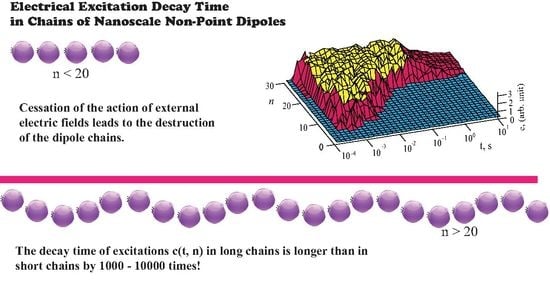Electrical Excitation Decay Time in Chains of Nanoscale Non-Point Dipoles
Abstract
1. Introduction
2. Model
3. Results and Discussion
4. Conclusions
Funding
Institutional Review Board Statement
Informed Consent Statement
Data Availability Statement
Acknowledgments
Conflicts of Interest
References
- Lewis, T.G. Interfaces nanometric dielectrics. Phys. D Appl. Phys. 2005, 38, 302–312. [Google Scholar] [CrossRef]
- Velev, O.D.; Kaler, E.W. In Situ Assembly of Colloidal Particles into Miniaturized. Langmuir 2005, 2111, 4874–4880. [Google Scholar] [CrossRef]
- Gierhart, B.C.; Howitt, D.G.; Chen, S.J.; Smithn, R.L.; Collins, S.D. Frequency Dependence of Gold Nanoparticle Superassembly by Dielectrophoresis. Langmuir 2007, 23, 12450–12456. [Google Scholar] [CrossRef] [PubMed]
- Bazant, M.Z.; Squires, T.M. Induced-charge electrokinetic phenomena. Curr. Opin. Colloid 2010, 15, 203–213. [Google Scholar] [CrossRef]
- Ramos, A.; Garca-Snchez, P.; Morgan, H. Induced-charge electrokinetic phenomena. A C Electrokin. Cond. Micropart A Rev. 2016, 24, 79–90. [Google Scholar] [CrossRef]
- Arnold, W. Particle patterning using fluidics and electric fields. IEEE T. Dielect. El. In. 2008, 15, 144–151. [Google Scholar] [CrossRef]
- Senyuk, B.; Liu, Q.; He, S.; Kamien, R.D.; Kusner, R.B.; Lubensky, T.C.; Smalyukh, I.I. Topological colloids. Nature 2012, 493, 200–205. [Google Scholar] [CrossRef]
- Vutukuri, H.R.; Smallenburg, F.; Badaire, S.; Imhof, A.; Dijkstra, M.; van Blaaderen, A. An experimental and simulation study on the self-assembly of colloidal cubes in external electric fields. Soft Matter 2014, 10, 9110–9119. [Google Scholar] [CrossRef]
- Vanyukov, V.; Mikheev, G.; Mogileva, T.; Puzyr, A.; Bondar, V.S.; Svirko, Y. Roadmap on optical metamaterials. Opt. Mater. 2014, 37, 218–222. [Google Scholar] [CrossRef]
- Lombardo, D.; Calandra, P.; Pasqua, L.; Magaz, S. Self–assembly of Organic Nanomaterials and Biomaterials: The Bottom–Up Approach for Functional Nanostructures Formation and Advanced Applications. Materials 2020, 13, 1048–1091. [Google Scholar] [CrossRef]
- Tang, Z.; Kotov, N.A. One-Dimensional Assemblies of Nanoparticles: Preparation, Properties, and Promis. Adv. Matter. 2005, 17, 951–962. [Google Scholar] [CrossRef]
- Grschel, A.H.; Mller, A.H.E. Self-assembly concepts for multicompartment nanostructures. Nanoscal 2015, 7, 11841–11876. [Google Scholar] [CrossRef] [PubMed]
- Fang, R.; Liu, M.; Jiang, L. Design of Nanoparticle Systems by Controllable Assembly and Temporal/Spatial Regulation. Adv. Funct. Matter 2019, 12, 1–17. [Google Scholar] [CrossRef]
- Colla, T.; Mohanty, P.S.; Njd, S.; Bialik, E.; Riede, A.; Schurtenberger, P.; Likos, C.N. Self-Assembly of Ionic Microgels Driven by an Alternating Electric Field: Theory, Simulations, and Experiments. ACS Nano 2018, 12, 4321–4337. [Google Scholar] [CrossRef] [PubMed]
- Ma, W.; Xu, L.; Wang, L.; Kuang, H.; Xu, C. Orientational nanoparticle assemblies and biosensors. Biosens. Bioelectron. 2016, 79, 220–236. [Google Scholar] [CrossRef]
- Lwen, H. Introduction to colloidal dispersions in external fields. Eur. Phys. J. Spec. Top. 2013, 222, 2727–2737. [Google Scholar] [CrossRef]
- Blaaderen, V.; Dijkstra, A.; van Roij, M.; Imhof, R.; Kamp, A.; Kwaadgras, M.; Liu, B.W. Manipulating the self assembly of colloids in electric fields. Eur. Phys. J. Spec. Top. 2013, 222, 2895–2909. [Google Scholar] [CrossRef]
- Zhang, J.; Luijten, E.; Granick, S. Toward Design Rules of Directional Janus Colloidal Assembly. Annu. Rev. Phys. Chem. 2015, 66, 581–600. [Google Scholar] [CrossRef]
- Finlayson, S.D.; Bartlett, P. Non-additivity of pair interactions in charged colloids. J. Chem. Phys. 2016, 145, 034905. [Google Scholar] [CrossRef]
- Gartner, T.E.; Jayaraman, A. Macromolecular ’size’and ’hardness’ drives structure in solvent-swollen blends of linear, cyclic, and star polymers. Soft Matter 2018, 14, 411–423. [Google Scholar] [CrossRef]
- Huang, J.Y.; Lai, P.Y. Formation and polarization of dipolar chains. Phys. Stat. Mech. Its Appl. 2000, 281, 105–111. [Google Scholar] [CrossRef]
- Fateev, E.G. Supersensitivity in a chain of closely spaced electric dipoles with variable moments. Phys. Rev. E 2002, 65, 021403. [Google Scholar] [CrossRef] [PubMed]
- Fateev, E.G. Chains of nanoscale dipoles in alternating electric fields. Tech. Phys. Lett. 2018, 44, 655–658. [Google Scholar] [CrossRef]
- Walker, D.A.; Kowalczyk, B.; de la Cruz, M.O.; Grzybowski, B.A. Electrostatics at the nanoscal. Nanoscal 2011, 3, 1316–1344. [Google Scholar] [CrossRef] [PubMed]
- Liljestrm, V.; Chen, C.; Dommersnes, P.; Fossum, J.O.; Grschel, A.H. Active structuring of colloids through field-driven self-assembly. Curr. Opin. Colloid 2019, 40, 25–41. [Google Scholar] [CrossRef]
- Hartel, A. Structure of electric double layers in capacitive systems and to what extent (classical) density functional theory describes it. J. Phys. Cond. Matter 2017, 29, 423002. [Google Scholar] [CrossRef]
- Dukhin, S.S.; Kretzschmar, G.; Miller, R. Dynamics of Adsorption at Liquid Interfaces: Theory, Experiment, Application; Elsevier: Amsterdam, The Netherlands, 1995; pp. 1–581. [Google Scholar]
- Stenqvist, B.; Trulsson, M.; Crassous, J. Modeling the assembly of oppositely charged lock- and key-colloids. Soft Matter 2019, 15, 5234–5242. [Google Scholar] [CrossRef]
- Jathavedan, K.; Bhat, S.K.; Mohanty, P.S. Alternating electric-field-induced assembly of binary mixtures of soft repulsive ionic microgel colloids. J. Colloid Interface Sci. 2019, 544, 88–95. [Google Scholar] [CrossRef]



| Parameter | Value |
|---|---|
| Number of uncompensated charges | |
| Size of nanoscale dipoles | nm |
| Number of dipoles in chain | n from 1 to 30 |
| Dipoles spacing in chain | a ( nm |
| Proton mass | kg |
| Strength of external low-frequency field | V/m |
| Frequency of external field | Hz |
| Relaxation time of bound charges | s |
| Dissipation parameter | |
| High-frequency dielectric permeability | F/m |
| Low-frequency dielectric permeability | F/m |
Publisher’s Note: MDPI stays neutral with regard to jurisdictional claims in published maps and institutional affiliations. |
© 2020 by the author. Licensee MDPI, Basel, Switzerland. This article is an open access article distributed under the terms and conditions of the Creative Commons Attribution (CC BY) license (http://creativecommons.org/licenses/by/4.0/).
Share and Cite
Fateev, E.G. Electrical Excitation Decay Time in Chains of Nanoscale Non-Point Dipoles. Nanomaterials 2021, 11, 74. https://doi.org/10.3390/nano11010074
Fateev EG. Electrical Excitation Decay Time in Chains of Nanoscale Non-Point Dipoles. Nanomaterials. 2021; 11(1):74. https://doi.org/10.3390/nano11010074
Chicago/Turabian StyleFateev, Evgeny G. 2021. "Electrical Excitation Decay Time in Chains of Nanoscale Non-Point Dipoles" Nanomaterials 11, no. 1: 74. https://doi.org/10.3390/nano11010074
APA StyleFateev, E. G. (2021). Electrical Excitation Decay Time in Chains of Nanoscale Non-Point Dipoles. Nanomaterials, 11(1), 74. https://doi.org/10.3390/nano11010074






